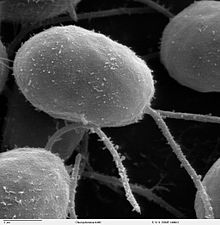Flagellate



A flagellate is a cell or organism with one or more
Form and behavior
Among
Flagella are generally used for propulsion. They may also be used to create a current that brings in food. In most such organisms, one or more flagella are located at or near the anterior of the cell, e.g., Euglena. Often there is one directed forwards and one trailing behind. Among animals, fungi, which are part of a group called the opisthokonts, there is a single posterior flagellum. They are from the phylum Mastigophora. They can cause diseases and are typically heterotrophic. They reproduce by binary fission. They spend most of their existence moving or feeding. Many parasites that affect human health or economy are flagellates. Flagellates are the major consumers of primary and secondary production in aquatic ecosystems - consuming bacteria and other protists.

Flagellates as specialized cells or life cycle stages
An overview of the occurrence of flagellated cells in eukaryote groups, as specialized cells of multicellular organisms or as life cycle stages, is given below (see also the article flagellum):[2][3][4]
- zoospores and male gametes, except in Zygnematophyceae), bryophytes (male gametes), pteridophytes (male gametes), some gymnosperms (cycads and Ginkgo, as male gametes)
- xanthophytes, eustigmatophytes
- apicomplexans(gametes)
- foraminiferans(as gametes)
- Cercozoa: plasmodiophoromycetes (zoospores and gametes), chlorarachniophytes (zoospores)
- myxogastrids
- chytridfungi (zoospores and gametes)
- acrasids (Pocheina, as zoospores)[6]
Flagellates as organisms: the Flagellata
In older classifications, flagellated
The autotrophic flagellates were grouped similarly to the botanical schemes used for the corresponding algae groups. The colourless flagellates were customarily grouped in three groups, highly artificial:[7]
- Protomastigineae, in which absorption of food-particles in holozoic nutrition occurs at a localised point of the cell surface, often at a cytostome, although many groups were merely saprophytes; it included the majority of colourless flagellates, and even many "apochlorotic" algae;
- Pantostomatineae (or Rhizomastigineae), in which the absorption takes place at any point on the cell surface; roughly corresponds to "amoeboflagellates";
- Distomatineae, a group of binucleate "double individuals" with symmetrically distributed flagella and, in many species, two symmetrical mouths; roughly corresponds to current Diplomonadida.
Presently, these groups are known to be highly
- glaucophytes(A)
- pedinellids(A/F)
- dinoflagellates (A/F), Colpodella(F)
- Rhizaria
- spongomonads (F), thaumatomonads (F), glissomonads (F), cryomonads (F), heliomonads/dimorphids (F), ebriids(F)
- Amoebozoa: Multicilia (F), phalansteriids (F), some archamoebae (F/S)
- choanoflagellates(F)
- Excavata
- heteroloboseans(P/F/S)
- hypermastigids, S)
- spironemids/hemimastigids, F), collodictyonids/diphylleids (F), Phyllomonas (F), and about a hundred genera[10]
Although the taxonomic group Flagellata was abandoned, the term "flagellate" is still used as the description of a
The amoeboflagellates (e.g., the rhizarian genus
References
- PMID 8868448.
- ^ Raven, J.A. 2000. The flagellate condition. In: (B.S.C. Leadbeater and J.C. Green, eds) The flagellates. Unity, diversity and evolution. The Systematics Association Special Volume 59. Taylor and Francis, London. pp. 269–287.
- ^ Webster, J & Weber, R (2007). Introduction to Fungi (3rd ed.). Cambridge: Cambridge University Press. pp. 23–24, [1]
- ^ Adl et al. (2012).
- ^ Lahr DJ, Parfrey LW, Mitchell EA, Katz LA, Lara E (July 2011). The chastity of amoebae: re-evaluating evidence for sex in amoeboid organisms. Proc. Biol. Sci. 278 (1715): 2083–6.
- OCLC 985464464.
- ^ Fritsch, F.E. The Structure and Reproduction of the Algae. Vol. I. Introduction, Chlorophyceae. Xanthophyceae, Chrysophyceae, Bacillariophyceae, Cryptophyceae, Dinophyceae, Chloromonadineae, Euglenineae, Colourless Flagellata. 1935. Cambridge, England: Cambridge University Press, [2].
- PMID 24239731.
- ^ Patterson, D.J. (2000). Flagellates: Heterotrophic Protists With Flagella. Tree of Life, [3].
- ^ Patterson, D.J., Vørs, N., Simpson, A.G.B. & O'Kelly, C., 2000. Residual Free-living and Predatory Heterotrophic Flagellates. In: Lee, J.J., Leedale, G.F. & Bradbury, P. An Illustrated Guide to the Protozoa. Society of Protozoologists/Allen Press: Lawrence, Kansas, U.S.A, 2nd ed., vol. 2, p. 1302-1328, [4].
- ISBN 0-521-30419-9.
- ^ Mikryukov, K.A. (2001). Heliozoa as a component of marine microbenthos: a study of Heliozoa of the White Sea. Ophelia 54: 51–73.
External links
- Flagellata at the U.S. National Library of Medicine Medical Subject Headings (MeSH)
- Leadbeater, B.S.C. & Green, J.C., eds. (2000). The Flagellates. Unity, diversity and evolution. Taylor and Francis, London.
- . Encyclopædia Britannica (11th ed.). 1911.
